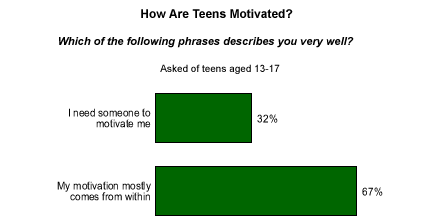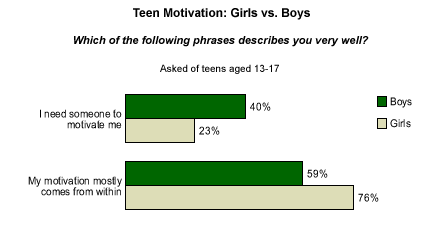Without proper motivation, few teens would master algebraic equations, read Proust, play the saxophone, learn Spanish, or even put gas in the family minivan. Fortunately for teachers and parents, most teens say they draw their motivation from within themselves, rather than from other people. Self-motivation -- the ability to encourage oneself to learn and achieve -- is an extremely desirable trait in our society. Many individuals are hardwired even at a young age to continually move forward and lead purposeful lives.
A recent Gallup Youth Survey* asked teens (aged 13 to 17) to choose a statement that describes them very well: "I need someone to motivate me," or "My motivation mostly comes from within." A majority of American teens, 67%, said they are mostly self-motivated, while 32% said they need someone else to motivate them.

External Forces
External motivation can also be a positive force, especially when it enhances basic internal drives. A good teacher will know how to tap into a student’s interests and goals; a good coach will know how to inspire each athlete to greater heights. Elizabeth, a senior on a New Jersey high school rowing team, thinks her motivation comes mostly from within, but appreciates the additional nudge from her coach. "She treats everyone differently in order to push them toward peak performance. She knows that not everyone responds to the same cues," she says.
External motivation often doesn’t come from parents, teachers, or coaches, but from friends. Peer pressure usually gets a bad rap, but friends can also be positive motivators. Scott, a 17-year-old from Wisconsin who likes to think he is mostly self-directed, admits that his peers also frequently motivate him. "In middle school, my friends decided to learn to play chess. I really wasn’t interested, so they got a 6-month head start. When I finally realized they were serious about it, I was miles behind them -- and the peer pressure to catch up and play well inspired me to work on it constantly. Now I am better than just about everyone I play with," he says.
Alcohol, Marijuana, and Motivation
Teens’ tendency to say they are self-motivated may be related to their overall self-esteem, which in turn is predictive of their likelihood to abuse drugs and alcohol. Twenty-nine percent of teens who said they need someone to motivate them also said they drink alcohol, compared with 15% of teens who said they are self-motivated and also said they drink. Similarly, 21% of teens who said they need others to motivate them also said they have tried marijuana, compared with 10% of teens who said they motivate themselves and also said they'd tried marijuana.
Influences Vary Between Boys and Girls
Responses to this question do not vary significantly among demographic groups, with one notable exception: Girls appear to be more self-motivated than boys are. While the majority of both sexes said their motivation mostly comes from within, 76% of girls said that describes them, compared with 59% of boys.

One concrete result of teen motivation is the desire to go to college. For about 30 years, the College Board has consistently recorded that females take the SAT -- the most widely accepted college placement exam -- in larger proportions than boys do. In the 2002-2003 academic year, girls constituted the majority of SAT test-takers once again -- 54% of females took the placement exam, compared with 46% of males. Happily for boys, the College Board reports the decline in male test-takers is subsiding.
Ken Mischner, a clinical social worker in Princeton, N.J., who often counsels adolescents in his family practice, explains girls’ self-motivation tendencies. "While adolescent boys may give the appearance of confidence and swagger," Mischner says, "it is really the girls who are centered -- more connected to their feelings. Even though it may appear less so, girls really know better what they’re doing and feeling."
*The Gallup Youth Survey is conducted via an Internet methodology provided by Knowledge Networks, using an online research panel that is designed to be representative of the entire U.S. population. The current questionnaire was completed by 517 respondents, aged 13 to 17, between Aug. 1 and Aug. 29, 2003. For results based on the total sample, one can say with 95% confidence that the maximum margin of sampling error is ±5 percentage points.